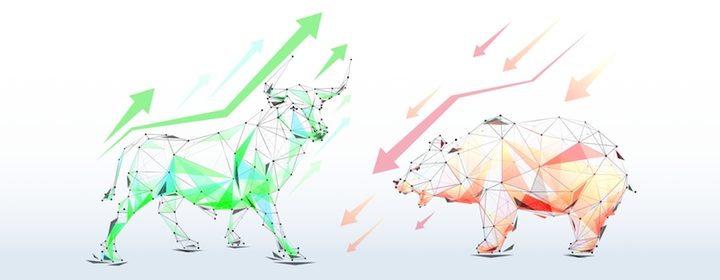If you regularly follow cryptocurrency news or scan social media for updates, you’ll likely encounter terms like “bear market” and “bull market.” These terms, originally from traditional finance, apply to all markets, including cryptocurrency trading. Understanding what they mean and how they may impact you as an investor is crucial.
The terms bear market and bull market are generally used to describe the direction a market is trending. To be more specific; Whether the market is heading up or down. These terms are typical reflections of investors’ feelings regarding the market. Usually, you will see the market value go up in light of good news and fall in the light of bad news. Other times, other factors will affect the market in unforeseen ways, such as “pump and dump” groups where a group strategically buy large amounts of a cryptocurrency to drive up the price.
NOTE: We advise against participating in such groups as more often than not this leads to the group owner dumping tokens on the members after making them pump the price.
Bull market
A bull market is used to describe a market where the market cap is increasing. Usually, you will see the term used when there is a stable increase in the price of an item. This means that trust in the market is high and investors feel optimistic about the state of the market. You can be a bullish investor if you plan to buy and keep your objects in the long run. This is safe and will be able to generate profits in the future.
The story of the bull market
The term bull market (Bullish Market) originates from sometime around 1714, but there are many versions of where the term originates. One theory is that it comes from the way a bull attacks its opponents. An ox lowers his head and uses his horns in an upward position so as to push them into an opponent. In the market, this applies when the market is low and begins to rise. In order to throw his opponent into the air. That is, a bull market comes when the market has been low so as to rise quickly.
Bull blood sport
Another theory that originates from the Elizabethan era in the late 16th century. At this time there was a sport called bull-baiting. This was a brutal sport where spectators saw a castrated bull being attacked by a group of dogs. This sport was banned in 1835. This is correlating quote well with the period the term first became known so many assume that this is where the term arose.
The Bull Board
Another theory comes from the London Stock Exchange. This stock market was established during the 17th century, which fits well with the year 1714. During the first years of the stock market, on the bulletin board traders brought up their trades called a bull.
How to identify a bull market
A bull market can be recognized by using a few key factors beyond just observing a consistently increasing trend. These factors do not always match, but are simple driving rules you can look for to identify a bull market.
Basic economy.
Supply and demand. In a bull market, there is a lot of optimism and confidence, so you usually see strong demand for a resource with a limited offer. Not many investors will sell since trust is high and many want to get into the market. Because of this, prices will increase.
Economic health.
When an economy is healthy, people will have more money to spend. A bull market can be a consequence of a healthy economy as investors have more money to spend on investment objects.
Human psychology.
Do you see negative news about your favorite currency and notice that the value decreases? This is due to simple human behavior and psychology. The thoughts and feelings of an investor acting on the market are an important influence on whether the market is rising or falling. In a bull market, trust is high and investors are optimistic about gaining profits.
For long-term purposes, use your preferred trading platform to keep track of recent trends and where bull market occurs. You can also find important news regarding bull market data to see how the market responds to different news and thus be better prepared to invest when similar news is being proposed.
Bear market

Bear market (bearish) describes a market that falls in value. The opposite of a bull market; When you see a consistent decline in the price of an asset you have probably identified a bear market. In this market, trust is low, which steers many investors away from investing in the asset.
As with the bull market, the term bear market originates from approximately 1714. The first theory of such market terminology stems from how the bear attacks. Imagine a bear waved with big paws up and down; knocks down his opponent. This symbolizes the downward trend we see in the bear market.
The Bare Board
Following the creation of The London Stock Exchange, traders posted offerings to buy shares. When the demand for stocks was low; the board was bare. This is said to be the origin of the term bear market; when the market was down.
How to identify a bear market.
A bear market can be identified in the same way as a bull market just with opposite details. One can see that the value of an object is in a consistent decline. The following factors are relevant to analyze if the market is bearish.
Basic economy.
In a bear market, the offer is high and demand low. In basic economics, this means that the price falls. This means that more people will sell than to buy.
Economic health.
A bear market can sometimes be associated with a weak economy. Investors want to spend less resources in weak economic times; A downward trend may lead investors to venture even further away.
Human psychology.
Human emotions and psychology govern the market. Sometimes one will find a bear market when market stability is at it’s worst. This may be blamed by other contributing factors such as fear, uncertainty, and doubt (FUD). Investors can, at such times, move their money to more stable objects. As the market is unpopular, this can damage investor trust and lead investors to stay away from the object. This leads to a fall in prices in the market.
A bear market can be a good time to start using some market indicators to see if an asset is oversold. This gives investors the opportunity to invest in promising assets at discounted prices.
Conclusion: Looking at historical market trends will be useful to identify bull vs bear markets.


